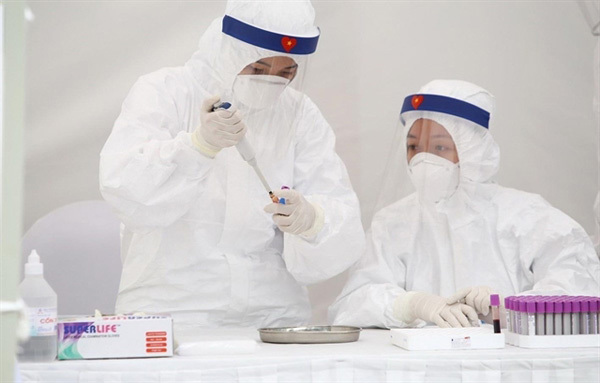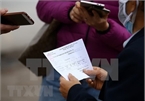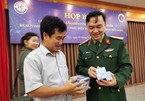 |
| CDC Hanoi staff taking samples for quick COVID-19 tests. VNA/VNS Photo Thanh Tung |
That’s when Vietnam discovered the 17th COVID-19 patient after twenty days of no new cases.
In the following month, the number of cases in Hanoi rose to 123. Tens of thousands of people connected to the positive cases in the city had to have their health checked and monitored, meaning a huge workload for the health workers at CDC, which is tasked with disease prevention and health risk reduction.
Each day, thousands of samples were taken to the headquarters of the centre for testing.
“Lab workers of the centre have been working round the clock for the past month, with four shifts a day,” said Nguyen Thi Kieu Anh, Deputy Director of Hanoi CDC.
Timely tests for the virus play a critical role in helping frontline healthcare workers detect patients infected with SARS-CoV-2 and promptly treat them, as well as reducing the risk of further human-to-human transmission in the city, she said.
These samples are taken by the centre’s 65 “flash teams”, also working around the clock amid the COVID-19 pandemic: checking, taking samples and isolating suspected cases.
Ha Tan Dung, Head of flash team number 3, hasn’t been able to visit his mother since the Tet (Lunar New Year) holidays. He has been staying at the medical centre to be ready whenever a new suspect is reported.
“Our work schedule is no schedule at all. We take command at any time and can be at the spot in only 15 minutes,” Dung said.
“We understand that if we’re one minute faster, we can prevent the infected case from having close contact with one healthy person,” he said.
Dung said all members of the quick response teams are working 200 per cent.
“Epidemiology work is an important job and it has to be very accurate and meticulous. Apart from identifying the infected cases and taking samples, we have to get information like their movement history, who did they have contact with, what kind of transport they used,” he said.
Kieu Anh, the CDC deputy director said her colleagues are potentially at risk of infections from handling specimens from patients with possible SARS-CoV-2 infection.
The test detects the genetic signature (RNA) of the SARS-CoV-2 virus in swab samples which are collected deep in the back of the patient’s throat or nose, and during the process of taking samples, health workers might get infected simply by breathing, she said.
But they don’t quit just because of the fear.
“If you asked whether we feel worried about potentially being infected, the answer is we do. But so what? If we don’t do these jobs, who else will? If we’re afraid, someone else has to do it anyway,” said Hung, head of CDC’s testing department.
Each team member of the “flash teams” has worked from 13 to 15 hours a day in the past month, Hung said.
“We have no time to lose since the sample testing results must be done as quick as possible so that positive cases are detected, isolated and treated quickly,” he said.
The lab workers are under no less time pressure.
Kieu Anh said most lab workers at the centre are women and they are conducting testing with the samples brought back by the flash team days and night.
Each shift lasts six hours, and they often have lunch at 3pm and dinner at 9pm.
“They work with a wonderful and responsible spirit. After each shift, their cheeks would go red and swollen, and I often feel like almost crying whenever I see them,” Kieu Anh said.
One day, when the power was off for three hours, all lab workers kept the N95 mask on their faces though it was really hard to breath.
“They'd rather keep the mask on all the time, not wanting to waste one as once they remove the mask it can no longer be re-used,” she said.
The workers can't scratch even if they feel itchy, they don’t even go to the toilet during their six-hour long shift, since the medical suit would easily be torn. It would be a waste, since each suit must be thrown away after each use.
There is a shortage of all medical equipment, including suits, masks, and even biological testing products.
“What do I wish for the most now? That we have adequate equipment so we can conduct all the tests needed,” she said.
CDC Vietnam: a special case
Deputy Director of the Hanoi CDC, Khong Minh Tuan, said although the centre has much to learn from the disease control models in other countries like the US, China, or Thailand, it has its own specialities.
In each locality of Vietnam, the CDC is a world full of initiatives, experience and sensitivity in disease monitoring and control, he said.
“While CDCs in other countries largely focus on the national scale, we have our “ears and eyes” working rather effectively at grassroots levels,” Tuan said.
“If the CDC at the national level is working well, it will help to have good, deep research. But in cases like this, if you have teams working at ward level, communal level, village level, you’ll be able to control and monitor the situation rather well. And that’s our success,” he said.
Doctors, nurses, and other frontline healthcare workers have been the unsung heroes of the novel coronavirus pandemic. We honour those who have stepped up to lead at all levels. They have helped us avert an even more daunting future and they continue to inspire us with their courage to make hard choices and do the right thing. — VNS
Thanh An

Hanoi plans more mobile COVID-19 testing stations to meet high demand
Hanoi intends to expand existing quick COVID-19 testing sites and set up new mobile testing stations to meet high demand of people suspected of carrying the novel coronavirus.

How did Vietnam develop its SARS-CoV-2 test kits?
SARS-CoV-2 virus test kit, developed and produced by the Military Medical Academy and Viet A Technology Company, is an important and necessary tool to help control Covid-19 in Vietnam.
 The light in the lab of the Hanoi Centre for Disease Control (CDC) hasn’t been off for a second since March 6.
The light in the lab of the Hanoi Centre for Disease Control (CDC) hasn’t been off for a second since March 6.